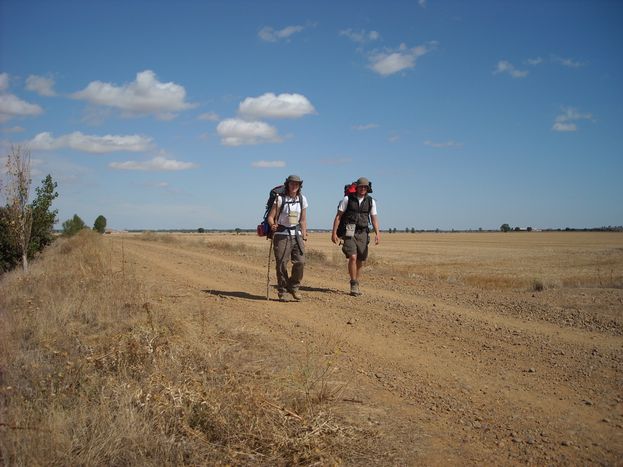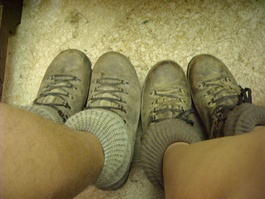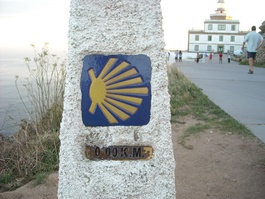
Spiritual Spain: two German pilgrims in Santiago de Compostela
Published on
Translation by:
Cafebabel ENG (NS)In 2009 more than 140, 000 people took the pilgrimage that ends at St. James cathedral in the Galician city of Santiago de Compostela. 14, 000 of those were Germans. We speak to two of them
Clubbing in Mallorca is too expensive. Rites of passage in north-western Spain? Right on. When Klara Gockel was making plans for her holidays in spring 2009, she ended up opting for Santiago de Compostela, aka ‘The Way of St. James’, instead. Another motivation was the successful book by Hape Kerkeling, I'm off then ('Ich bin dann mal weg', 2001). The German comedian and author was lauded the Bill Bryson of his country.
Klara read the book by chance, which is a favourite on German bookshelves. In it, Kerkeling describes his 800km spiritual journey along the Camino de Santiago. ‘Initially I wanted to go alone,’ explains the dentistry student from the city of Herne, but she ended up convincing an initially sceptical old schoolfriend, nursing undergraduate Felix Wenzel. They read travel books, learnt some basic Spanish and joined ‘pilgrimage groups’ dedicated to the subject on the German university social network StudiVZ. Looking back, they laugh at their enthusiasm. ‘We met people along the way who were walking barefoot!’ Klara and Felix thought such suffering was unnecessary; the students were happy with their essentials, which included a good pair of walking shoes as well as wet wipes.
24 km a day, 7 days a week for 6 weeks
 In August 2009 the pair took the most popular route, the Camino Francés, which stretches for 780 kilometres or almost 500 miles from the Pyrenees to the north-west of Spain. It took six weeks, and they walked twenty-four kilometres a day without taking breaks, although Klara cites the importance of their ‘evening anointments’, where they tended to their sore feet and walking wounds. Other pilgrims had different care solutions; one cut out the heels of their shoes which were a bit too small without thinking twice. The highlights of the experience were the exchanges with fellow pilgrims, such as a Dutch grandfather and his grandson, although sleeping on the top bunk with a whining older German woman on the bottom bunk in a cramped hostel was sometimes not the best fun. ‘You’re never alone with pilgrims,’ says Felix.
In August 2009 the pair took the most popular route, the Camino Francés, which stretches for 780 kilometres or almost 500 miles from the Pyrenees to the north-west of Spain. It took six weeks, and they walked twenty-four kilometres a day without taking breaks, although Klara cites the importance of their ‘evening anointments’, where they tended to their sore feet and walking wounds. Other pilgrims had different care solutions; one cut out the heels of their shoes which were a bit too small without thinking twice. The highlights of the experience were the exchanges with fellow pilgrims, such as a Dutch grandfather and his grandson, although sleeping on the top bunk with a whining older German woman on the bottom bunk in a cramped hostel was sometimes not the best fun. ‘You’re never alone with pilgrims,’ says Felix.
Religion played no role in this pilgrimage. For Klara and Felix undertaking this adventure was more about achieving a physical feat. It was about immersing oneself into the world of the pilgrimage and disconnecting from reality. ‘Everytime I spoke to my mum on the phone she’d pop a little flag on the exact location we were on a map,’ laughs Felix. ‘When I came back I saw it and it showed me how sometimes we’d just be lost for days on end without giving signs of life.’ ‘We didn’t miss anything during this trip,’ adds Klara. ‘Sometimes we’d cheat and have a refreshing coca-cola instead of the constant running water we were drinking. Sometimes it was nice to use a real towel instead of our small micro-fibre ones.’ The ‘pilgrim effect’ helped Klara lose her appreciation for the small things in life. ‘I always liked showering in the evenings and I love using a good towel at home. But when these things are so far away you kind of just forget them.’
 After six weeks of walking during the days, spending nights in cramped conditions and in daily unctions, Klara didn’t feel like she’d actually walked the Santiago de Compostela when they finally reached their destination. ‘It was a rainy day, and we’d already decided to keep going until the end of the world.’ They ended up at the sea at Finisterre, around ninety kilometres from Santiago.
After six weeks of walking during the days, spending nights in cramped conditions and in daily unctions, Klara didn’t feel like she’d actually walked the Santiago de Compostela when they finally reached their destination. ‘It was a rainy day, and we’d already decided to keep going until the end of the world.’ They ended up at the sea at Finisterre, around ninety kilometres from Santiago.

‘The panoramic view was just crazy,’ remembers Felix. ‘The pilgrimage technically ended there. Seeing the sunset and the sea was just an incredible sensation.’ The pilgrim effect might have disappeared since, but its impact has remained. Klara and Felix recorded their trip directly on their skin; she got a tattoo of a white cockle shell (the symbol of Santiago) on her ankle and Felix got one on his foot.
Images: ©Klara Gockel, Felix Wenzel
Translated from Jakobsweg: Tägliche 'Salbungen' in der Pilgerwelt



